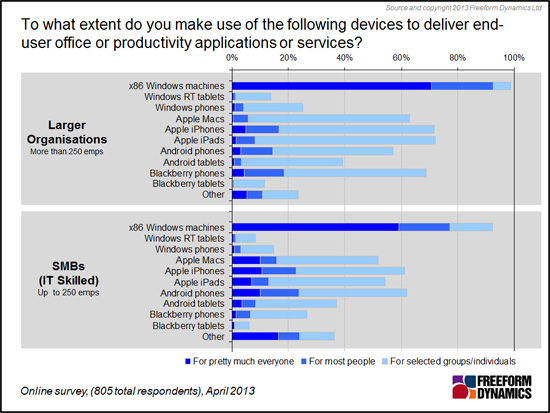By Dale Vile
Ask anyone in the industry about the future of end user computing and the chances are that the response will major heavily on smartphones and tablets, and perhaps BYOD in relation to these. This is perfectly understandable as mobile technology is both seductive and fast moving, and many IT departments haven’t yet got things under control in this space. Everyone is therefore interested in discussions about how usage patterns are going to develop, and how best to manage the proliferation of mobile end-points, particularly when the business may not own some of them.
We then have an ongoing line of coverage in the press to do with the so called ‘post-PC era’, fuelled by market numbers showing a decline in PC shipments while sales of mobile devices continue to climb. You would get the impression from many of the stories that reliance on the desktop PC, and even laptops and notebooks, is dwindling, with these ‘old-fashioned’ form-factors destined to die out in the not too distant future.
In all this excitement and speculation, the danger is that we lose sight of the continuing importance of desktops and laptops. The truth is that mobile workers are in the minority in most workforces, and this isn’t going to change in a hurry, so traditional fixed desktop computing still needs to be taken care of:

The other important observation from this chart is that a significant number of mobile and field-based workers fall into the ‘knowledge worker’ category, which basically means they have a need to create, consume, manipulate and distribute documents and other information as part of their job. It isn’t the kind of activity that can be done comfortably or efficiently on a limited function pure touch mobile device. This is why smartphones and tablets used by mobile information workers today typically complement a full function PC, which is most likely to be an x86 Windows machine:

Of course the exact form-factor of the fully functional device is likely to change over time, with various ‘convertible’ and ‘transformer’ style options finding their place, as well as tablets such as Microsoft’s Surface Pro which have a clip-on keyboard that doubles up as a cover. Those who are only partly mobile may be content with a less portable machine that remains at their desk while they are out and about with their iPad or similar.
The point is that end-user computing is not a zero-sum game. Just because people are adopting smartphones and tablets, and hooking them into corporate systems, doesn’t mean they are no longer reliant on a full desktop experience for a significant part of their work. When you consider this alongside the sizable part of the employee population that will always work from fixed location, it’s clear that mice, keyboards and large/multiple displays, along with access to a reasonable degree of processing power and storage capacity, will remain a critical part of business computing for the foreseeable future.
The trouble is that a lot of organisations have been ‘sweating their assets’ in relation to PC software and hardware. There’s a lot of Windows XP out there running on ageing equipment that is not only behind the curve in terms of functionality and user experience, but is also becoming even more expensive to manage as it gets older. With XP’s end-of-life looming, something has to be done in the near future.
However, before jumping into that next desktop refresh/migration project, we would advise taking a step back and considering your end-user computing strategy holistically. As the lines blur between different classes of device, there is a strong case to be made for putting policy, process and technology in place in a coordinated way to deal with requirements across the whole fixed-mobile spectrum of activity. The anchor points for this are the user at one end, and the information or service at the other, with an assumption that the bit in the middle (i.e. devices and networks) will be variable.
Easier said than done, perhaps, but some have already created a headache for themselves by trying to tackle application delivery, security and management separately for company mobile devices, personal devices, corporate PCs, home PCs, Apple Macs, and so on. In future discussions, we’ll therefore be looking at solutions, including various forms of desktop virtualisation, for example, that can potentially help across the board.
In the meantime, the imperative is not to fall into the trap of neglecting your desktop estate. Your business will undoubtedly start to hurt if you let it fall into disrepair, while investment in modernisation will yield tangible business benefits.
CLICK HERE TO VIEW ORIGINAL PUBLISHED ON

Dale is a co-founder of Freeform Dynamics, and today runs the company. As part of this, he oversees the organisation’s industry coverage and research agenda, which tracks technology trends and developments, along with IT-related buying behaviour among mainstream enterprises, SMBs and public sector organisations.





Have You Read This?
From Barcode Scanning to Smart Data Capture
Beyond the Barcode: Smart Data Capture
The Evolving Role of Converged Infrastructure in Modern IT
Evaluating the Potential of Hyper-Converged Storage
Kubernetes as an enterprise multi-cloud enabler
A CX perspective on the Contact Centre
Automation of SAP Master Data Management
Tackling the software skills crunch